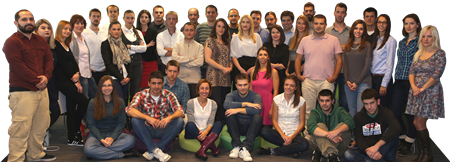How to Measure Anything: Finding the Value of `Intangib
| Cena: |
| Želi ovaj predmet: | 5 |
| Stanje: | Polovan bez oštećenja |
| Garancija: | Ne |
| Isporuka: | Pošta CC paket (Pošta) Post Express Lično preuzimanje |
| Plaćanje: | Tekući račun (pre slanja) Lično |
| Grad: |
Beograd-Zvezdara, Beograd-Zvezdara |
ISBN: 0470539399
Godina izdanja: 2010
Jezik: Engleski
Oblast: Menadžment
Autor: Strani
Douglas W. Hubbard - How to Measure Anything: Finding the Value of `Intangibles` in Business
Wiley, 2010
304 str.
tvrdi povez
stanje: vrlo dobro
2nd edition
Anything can be measured. This bold assertion is the key to solving many problems in business and life in general. The myth that certain things can`t be measured is a significant drain on our nation`s economy, public welfare, the environment, and even national security. In fact, the chances are good that some part of your life or your professional responsibilities is greatly harmed by a lack of measurement--by you, your firm, or even your government. Building up from simple concepts to illustrate the hands-on yet intuitively easy application of advanced statistical techniques, `How to Measure Anything, Second Edition` reveals the power of measurement in our understanding of business at the world at large. This insightful and engaging book shows you how to measure those things in your business that, until now, you may have considered `immeasurable,` including technology ROI, organizational flexibility, customer satisfaction, and technology risk. Offering examples that will get you to attempt measurements--even when it seems impossible--this book provides you with the substantive steps for measuring anything, especially uncertainty and risk.
Contents:
Section I. Measurement: the solution exists: Intangibles and the challenge: Yes, I mean anything ; The proposal
An intuitive measurement habit: Eratosthenes, Enrico, and Emily: How an ancient Greek measured the size of the earth ; Estimating: be like Fermi ; Experiments: not just for adults ; Notes on What to learn from Eratosthenes, Enrico, and Emily
The illusion of intangibles: why immeasurables aren`t: The concept of measurement ; The object of measurement ; The methods of measurement ; Economic objections to measurement ; The broader objection to the usefulness of `statistics` ; Ethical objections to measurement ; Toward a universal approach to measurement
Section II. Before you measure: Clarifying the measurement problem: Getting the language right: what `uncertainty` and `risk` really mean ; Examples of clarification: lessons for business from, of all places, government
Calibrated estimates: how much do you know now?: Calibration exercise ; Further improvements on calibration ; Conceptual obstacles to calibration ; The effects of calibration
Measuring risk through modeling: How not to measure risk ; Real risk analysis: the Monte Carlo ; An example of the Monte Carlo method and risk ; Tools and other resources for Monte Carol simulations ; The risk paradox and the need for better risk analysis
Measuring the value of information: The chance of being wrong and the cost of being wrong: expected opportunity loss ; The value of information for ranges ; The imperfect world: the value of partial uncertainty reduction ; The epiphany equation: how the value of information changes everything ; Summarizing uncertainty, risk, and information value: the first measurements
Section III. Measurement methods: The transition: from what to measure to how to measure: Tools of observation: introduction to the instrument of measurement ; Decomposition ; Secondary research: assuming you weren`t the first to measure it ; The basic methods of observation: if one doesn`t work, try the next ; Measure just enough ; Consider the error ; Choose and design the instrument
Sampling reality: how observing some things tells us about all things: Building an intuition for random sampling: the jelly bean example ; A little about little samples: a beer brewer`s approach ; Statistical significance: a matter of degree ; When outliers matter most ; The easiest sample statistics ever ; A biased sample of sampling methods ; Measure to the threshold ; Experiment ; Seeing relationships in the data: an introduction to regression modeling ; One thing we haven`t discussed, and why
Bayes: adding to what you know now: Simple Bayesian statistics ; Using your natural Bayesian instinct ; Heterogeneous benchmarking: a `brand damage` application ; Bayesian inversion for ranges: an overview ; Bayesian inversion for ranges: the details ; The lessons of Bayes
Section IV. Beyond the basics: Preference and attitudes: the softer side of measurement: Observing opinions, values and the pursuit of happiness ; A willingness to pay: measuring value via trade-offs ; Putting it all on the line: quantifying risk tolerance ; Quantifying subjective trade-offs: dealing with multiple conflicting preferences ; Keeping the big picture in mind: profit maximization versus purely subjective trade-offs
The ultimate measurement instrument: human judges: Homo absurdus: the weird reasons behind our decisions ; Getting organized: a performance evaluation example ; Surprisingly simple linear models ; How to standardize any evaluation: Rasch models ; Removing human inconsistency: the lens model ; Panacea or placebo?: questionable methods of measurement ; Comparing the models
New measurement instruments for management: The twenty-first-century tracker: keeping tabs with technology ; Measuring the world: the Internet as an instrument ; Prediction markets: a dynamic aggregation of opinions
A universal measurement methods: applied information economics: Brining the pieces together ; Case: the value of the system that monitors your drinking water ; Case: forecasting fuel for the Marine Corps ; Ideas for getting started: a few final examples ; Summarizing the philosophy
Appendix: Calibration tests (and their answers)
Nonfiction, Management, 0470539399
Plaćanje pouzećem i postnetom za sada nisu opcija.
Lično preuzimanje je isključivo na Konjarniku uz prethodni dogovor.
Hvala na razumevanju.
Predmet: 79806917









